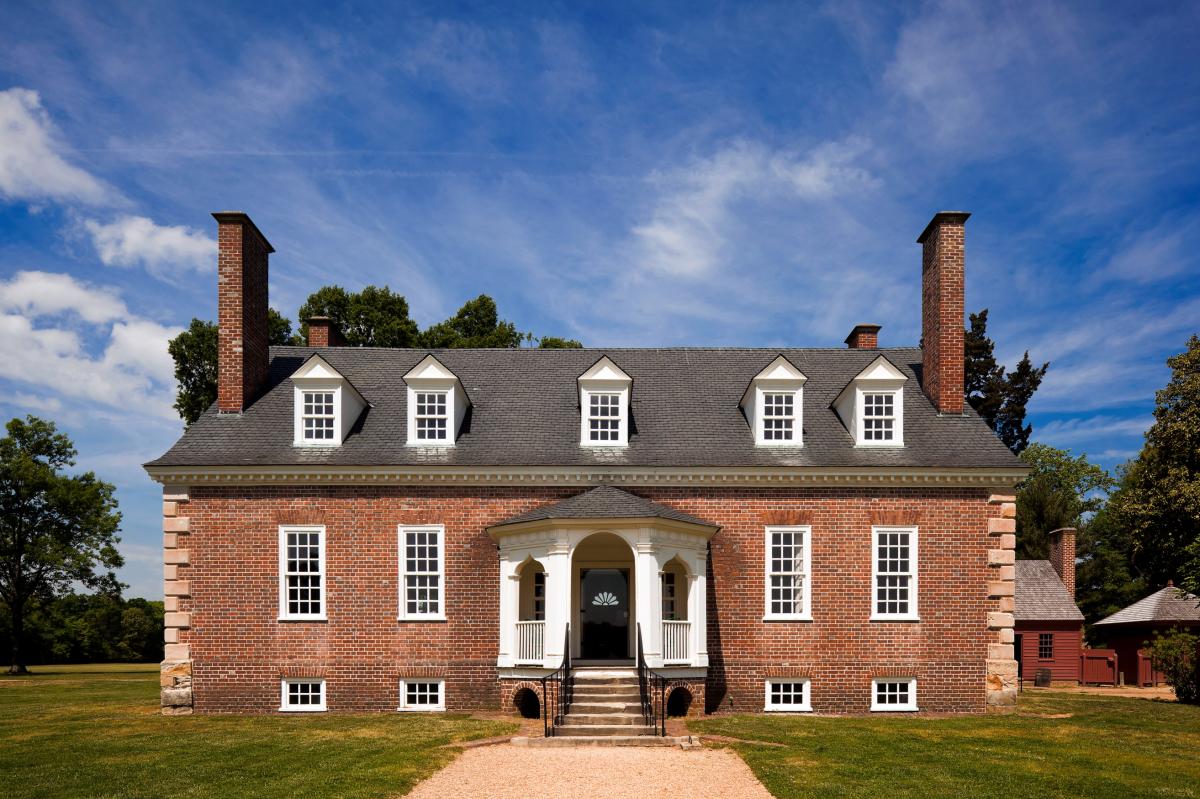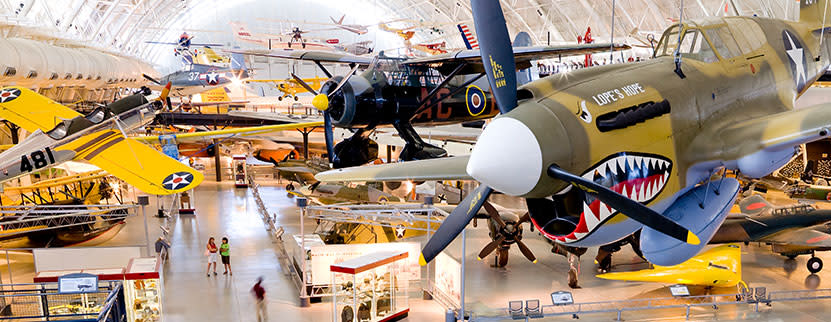Imagine being an architect of the Bill of the Rights, a delegate to the Constitutional Convention, an OG Patriot and a Founding Father. Yet 250 years later, all anyone can talk about is the guy next door.
It’s hard to fathom that two men as influential as George Mason and George Washington lived at the same time—practically next door to each other as the fish swims—and managed to establish a democracy with a Constitution and Bill of Rights that are all still very relevant today. Their words and intentions are still honored, interpreted and debated on a daily basis all these years later.
Mason was born in Fairfax County and both were raised here. They attended the same church. They visited each others’ homes. If not exactly friends, they were friendly. And they left their historic legacies here at their homes and museums. If you want to know why the Patriots broke with the British, how they architected a new nation, what the thinking was behind it all and how it still impacts us today, there is only one place that tells the story in context—the Potomac Banks region of Fairfax County.
George Washington, the founding father of all founding fathers

Built in 1758, George Washington’s Mount Vernon estate is the most visited, most popular historic home in the nation. It’s not because of the Palladian architecture or its jaw-dropping siting, overlooking the Potomac River. It’s because of the man who was raised there and lived there until his death.
George Washington's Life
Learn more
Washington was a surveyor-turned-soldier who, along with other colonists, grew alarmed at the rising taxes and increasing control the British Crown was imposing upon them after years of being left largely alone. Dissatisfaction grew until the colonies were moved to fight for their independence from the Crown.
George Washington was already prominent before the Revolution—a gentleman farmer who commanded the Virginia Regiment during the French and Indian War. That led to his election to the Virginia House of Burgess and he was named a delegate to the Continental Congress in Philadelphia, which appointed him Commander in Chief of the Continental Army in 1775. In that position, Washington commanded the insurrection against the British and led the Patriots to a decisive victory in the Revolutionary War.
When the war concluded in 1783, Washington resigned his commission, hoping to return to his peaceful life. He was a hero in the new nation, however, and was implored to keep answering the call. In 1787, he was unanimously elected president of the Constitutional Convention. And two years later, he was unanimously elected the first President of the United States. Washington served two terms as president and died two years after his presidency.
Washington modeled the ideals we all have for presidents. He put his own desires aside to serve his nation. He tempered his ego, leaving office after two terms and establishing that norm. He brought our country into a new balance during a chaotic time. He established and demonstrated the peaceful transfer of power. His 1796 farewell address was a preeminent statement on republicanism stressing the importance of national unity and the dangers that regionalism, partisanship, and foreign influence pose to it. Ans as a result of all of this, George Washington is considered by both citizens and scholars as one of the greatest presidents in American history.
What to see and do near Mount Vernon

Mount Vernon is in the heart of Fairfax County’s Potomac Banks region, filled with American history. It has a museum on site, as well as multiple exhibits and demonstrations to see on the property. Nearby, you’ll find George Washington’s Distillery and Gristmill where they still make spirits according to Washington’s ways. Also nearby is Woodlawn, an historic home that Washington built for Martha Washington’s granddaughter, Nellie Parke Custis. This site also has Civil War significance and, surprisingly, a Frank Lloyd Wright home to tour.

As an FYI, you’ll need a weekend to give justice to all these sites because Mount Vernon alone will take the bulk of a day to explore. We recommend eating at the Mount Vernon Inn, both for the convenience and quality of food. Afterward, try the veteran-owned Woodlawn Press Winery. And, speaking of veterans, the National Museum of the US Army is situated between Mount Vernon and Gunston Hall—hard to pass by on your founding father’s tour. Of course, no exploration of George Washington would be complete without making the 20-minute drive to see our country’s most iconic monument in the city that bears George’s name.
George Mason, the founding father who architected our freedoms

Photo Courtesy Gunston Hall
In the 1770s, George Mason was a planter and country squire who was growing increasingly frustrated with the constraints of British rule. Rather than march off to war, however, he used his pen and his intelligence against the Crown, finding ways around the around the Stamp Act of 1765 and serving in the pro-independence Virginia Conventions in 1775 and 1776.
George Mason's Life
Learn more
In the 1770s, George Mason was a planter and country squire who was growing increasingly frustrated with the constraints of British rule. Rather than march off to war, however, he used his pen and his intelligence against the Crown, finding ways around the around the Stamp Act of 1765 and serving in the pro-independence Virginia Conventions in 1775 and 1776.
Mason authored the Fairfax Resolves in 1774, in part in response to the punishments imposed upon Bostonians by the British after the Boston Tea Party. He was asked by Washington and other political leaders of the day to write it. While other colonies drafted similar resolves, Mason’s was considered the best and most detailed. It said of the Crown, “We are its subjects and we will use every means heaven hath given us to prevent our becoming its slaves.” That statement, while strong and heartfelt, was also filled with irony, as we’ll discuss below.
In 1776, Mason drafted the Virginia Declaration of Rights. Thomas Jefferson and others sought to have their words and ideas at the forefront, but Mason’s version could not be stopped. As a member of the House of Delegates and the Virginia General Assembly, he was a powerful political figure during the Revolution. This document later served as a blueprint for our nation’s Bill of Rights.
Mason served as one of his state's delegates to the Constitutional Convention in 1787. That trip to Philadelphia was one of the only times he left Virginia. While there, his left his stamp on many clauses in our Constitution. Then he refused to sign it, which is why you won’t find his name there with John Hancock’s. For Mason, it didn’t go far enough to end slavery, protect shipping and, at that time, it didn’t yet have a Bill of Rights. The Bill of Rights would later be written using Mason’s words and ideas.
Mason lived long enough to see a new, independent nation powered, in part, by his words and accomplishments. But he died a few years later in 1792. To recap, Mason was a passionate supporter of freedom and rose above many of the leaders in that day to architect critical parts of our Constitution and Bill of Rights, both of which hold the vision of the nation we live in today. He was respected and even admired by men like Washington, Jefferson, John Adams and Benjamin Franklin. His accomplishments were game-changing. Yet his story has escaped modern awareness.
 Photo Courtesy of Gunston Hall
Photo Courtesy of Gunston Hall
Mason’s legacy can be explored at George Mason’s Gunston Hall, his Potomac Riverfront home for more than 30 years. It was built by William Buckland, a British architect who designed many Colonial-era buildings. In late 2023, the riverside gardens were restored to their original splendor, featuring historic varieties of fruits, vegetables, plants and shrubs.
What to see and do around Gunston Hall

When you go to visit Gunston Hall, you may wonder if you’re a little lost. Because you turn off the highly populated Route 1 area and immediately enter into a forest. Then you drive a couple miles into the trees, with no signs of human life anywhere. Roam through the captivating scenery of Pohick Bay Regional Park and Mason Neck State Park with its large bald eagle population. A visit to one of these parks is a must.
 Photo Courtesy Mina Habibi at the Workhouse Arts Center
Photo Courtesy Mina Habibi at the Workhouse Arts Center
If you want more of a side trip, visit the Workhouse Arts Center, an artist colony housed in a former prison. Don’t miss the suffragist history at the prison and nearby. It’s a shocking story that most people have never heard. To eat, try Hometown Grill and Bar in Lorton Station, followed by a local brew at G34.3 Brewing Company. There is a memorial dedicated to George Mason about a half hour north of his estate in Washington, DC.
Where the Georges merged
 Photo Courtesy Pohick Church's Facebook
Photo Courtesy Pohick Church's Facebook
George Washington and George Mason lived less than 10 miles from each other—maybe 4 miles if you went by boat. They lived in similar looking homes, both sited on peninsulas of the Potomac River. They served in the Virginia House of Burgess together. They visited each other often. And they even worshipped at the same church where they were both vestrymen. Pohick Church still stands today, with its 12th century baptismal font, Civil War graffiti and Washington family pew.
 Photo Courtesy Cameron Davidson for Virginia Tourism Corporation
Photo Courtesy Cameron Davidson for Virginia Tourism Corporation
The Georges interacted frequently and were friendly, but there was strained tension between them because they had different ideals and different ambitions.
Find out more where the Georges diverged
Learn more
Washington felt Mason was more driven by self-interests while Washington felt his own interests were for the common good. This may or may not have been true. Part of Washington’s lore is that he desperately wanted to return to his peaceful farming life after the Revolution but had reached hero status and was called to serve as president. Meanwhile, George Mason got to live the gentleman farmer’s life that George craved. Washington got the status, power and enduring admiration and Mason got the crops and pigs and relative obscurity. Depending on your perspective, it’s hard to determine who came out on top.
But they did share one of the most confounding ironies of that time, one that was viral among founding fathers. Most of these men, Washington and Mason included, were passionate about freedom and securing it for the new nation. Yet they owned slaves until the day they died. George Mason was especially vocal about the evils of slave importation. But only a small handful of our founding fathers (John Adams, John Quincy Adams and Thomas Paine among them) put their money where their mouths were in regard to slavery. Established in 1833, nearby Gum Springs was a free black community founded by a Washington-family slave that worked at Mount Vernon, West Ford. Woodlawn also has some significant history in enabling freedom for blacks in the south.
Set aside enough time for a thorough exploration of the Georges.

George Washington and George Mason were both complex men whose lives were aligned in creating our nation, but whose legacies took different trajectories. These two Fairfax County residents went on to establish the freedoms we hold today, one as a great warrior and president, and the other as the architect of our independence. And they lived very close to each other, making their historic homes perfect for a founding father weekend tour you won’t find anywhere else in the nation.
With Washington, DC, two Smithsonian Air and Space Museums and sites like Great Falls Park calling to your curiosity, you could spend a week in Fairfax County without seeing it all! Put some of these stops on your Fairfax County itinerary today. Which site will you visit first? Let us know in the comments below or share with us on social media using #FXVA and @VisitFairfax.





